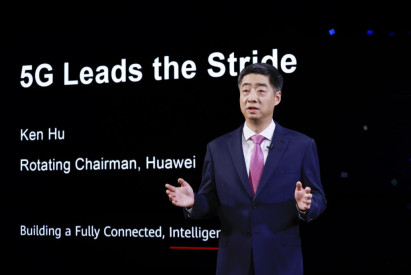
Global tech powerhouse Huawei Technologies is calling for strong collaboration among ICT players to capitalise on the power of 5G to lead a global economic recovery as businesses continue to struggle in the wake of the Covid-19 pandemic.
The firm’s top brass told a forum yesterday at the Queen Sirikit National Convention Center in Bangkok that the company is bullish that new applications and business models enabled by 5G infrastructure offer unprecedented opportunities for the expansion of entire industries, while digitalisation across thousands more would bring about the next wave of global economic development.
Ken Hu, Huawei’s rotating chairman, said 5G network capabilities need to be fully realised and that value fully mined as global 5G coverage has yet to extend beyond 30% of the world’s population.
“5G has grown faster than any previous generation of mobile technology,” said Mr Hu.
“There has been solid progress in the network deployment, consumer services and industry applications in just three years,” he said.
“We need to work together to fully unleash the power of 5G networks and expand into services like cloud and system integration.”
He delivered the remarks at Huawei’s 13th Global Mobile Broadband Forum (MBBF), which kicked off yesterday.
The two-day event is being held in association with the Global System for Mobile Communications Association (GSMA) and Global TD-LTE Initiative (GTI).
The event gathers mobile network carriers, industry leaders, and ecosystem partners from around the globe to discuss how to make 5G a commercial success as well as related topics, such as green development, artificial intelligence, and the evolution of 5G.
According to Mr Hu, new mobile applications that take advantage of 5G are already contributing to steady growth in carrier revenues from connectivity and becoming a new engine for adding value in related industries like oil and gas, manufacturing and transportation.
As of October, more than 230 carriers across the world had launched commercial 5G services.
Moreover, three million 5G base stations have been established, serving more than 700 million subscribers globally.
As 5G becomes more prevalent, it delivers a superior experience for customers, including a rise in high-definition video traffic, he said.
“New 5G mobile applications have doubled average user data consumption and are increasing average revenue per user by 20-40%,” Mr Hu said.
5G business-to-business (B2B) applications are not only innovative but also deliver real commercial value for carriers.
In 2021, for example, Chinese carriers brought in over US$500 million (19.145 billion baht) in new revenue from more than 3,000 industrial 5G projects.
These projects also generated 10 times that amount from related data and integrated ICT services.
Applications for the B2B sector that harness 5G are set to become the fastest-growing revenue stream for carriers, he said.
“After more than 10 years of research, investment and application exploration, 5G has entered the fast track of development,” said Mr Hu. “This is just the beginning. We can further unlock the value of 5G.”
THREE APPROACHES NEEDED
Mr Hu highlighted three key elements to support 5G usage. The first lies in efforts to build out 5G networks for better user experience.
He said networks should be built in a way that optimises different types of user experience. For example, Chinese carriers have optimised their networks for short-video platform TikTok and other popular video services, reducing first input delay by 50% and frame freezing by 90%.
The second concerns efforts to pursue 5.5G development, which can bring ultra-fast internet networks to the next level.
“Huawei worked with carriers and industry partners to propose four features for 5.5G, the next evolution of 5G technology: 10 gigabits per second (Gbps) downlink, 1 Gbps uplink, support for 100 billion connections, and native intelligence,” said Mr Hu.
Finally, the value of 5G can be maximised with service innovation.
He said 5G can be integrated with cloud and Artificial Intelligence (AI) to provide entirely new services for consumers and businesses.
Carriers can deliver new experiences like extended reality (XR), cloud gaming, and enriched calling services for individual consumers, and provide enterprises with more comprehensive digital transformation solutions, he added.
Yesterday, the Office of the National Digital Economy and Society Commission, National Telecom, Huawei as well as Information and Communication Networks Plc jointly witnessed the launch of a new 5G city white paper and the first 5G smart city in the Eastern Economic Corridor.
UNLOCKING 5G VALUE
James Chen, president of the global sales department at Huawei’s Carrier Business Group, pointed out that to unlock the value of 5G, it is vital to accelerate deployment and make the most of every frequency band.
He said 5G networks are 10 times faster than 4G, delivering speeds greater than 1 Gbps, while 5G users consume two times more data than 4G users — more than 20 gigabytes a month.
This creates opportunities for mobile operators from three perspectives.
First, the ultra-fast internet network can level up user experience, which can boost consumption and revenue for carriers.
The operators can offer 5G packages priced based on other factors, such as speed, latency and uplink experience.
Second, IoT devices are gathering steam, supported in both the consumer and industrial sectors.
Finally, for industrial digitalisation, 5G provides high-quality connections and services that help carriers expand into the B2B market.
Mr Chen said all spectrum bands can be utilised for 5G, though different bands produce optimal performance in different scenarios.
The development of energy-efficient 5G also needs to consider three separate layers — equipment, sites and networks, which can help maximise output and build 5G networks with optimal performance and energy efficiency, he added.

